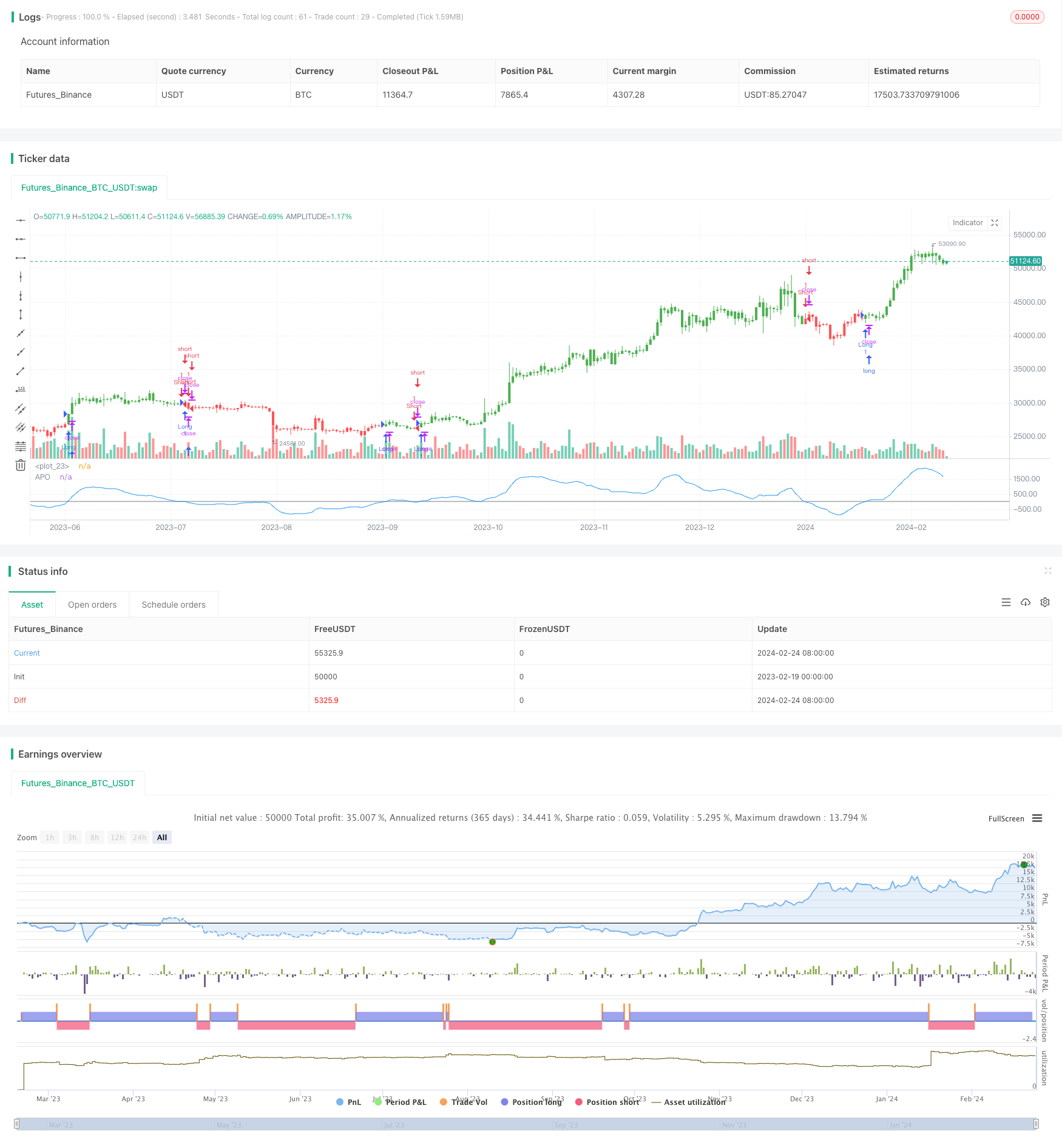
概述
双EMA价格摆动策略通过计算两个不同期限的EMA之间的差值,来判断市场的多空态势和力度。当快线和慢线之间差值上穿0时为看涨信号。当快线和慢线之间差值下穿0时为看跌信号。
该策略简单易用,通过EMA的差值判断市场力度和方向。但是也存在一定的滞后性,无法及时捕捉turning point。
策略原理
双EMA价格摆动策略的核心指标是APO,即Absolute Price Oscillator,表示两个EMA之间的差值。其计算公式如下:
APO = EMA(短期) - EMA(长期)
具体来说,本策略中APO的计算为:
xShortEMA = ema(收盘价, LengthShortEMA)
xLongEMA = ema(收盘价, LengthLongEMA)
xAPO = xShortEMA - xLongEMA
其中LengthShortEMA和LengthLongEMA分别代表短期和长期EMA的周期长度。
APO几个关键判断规则:
- 当APO上穿0时为看涨信号
- 当APO下穿0时为看跌信号
- APO为正表示目前处于看涨状态
- APO为负表示目前处于看跌状态
根据APO的实时值来判断市场的多空状态和进入时机。
优势分析
双EMA价格摆动策略具有以下几个主要优势:
- 使用指数移动平均线,能够有效平滑价格数据,减少噪音的影响
- APO指标结合两个EMA,能够同时判断价格趋势和市场力度
- 策略信号简单清晰,容易判断和实现
- 可自定义EMA周期,适应不同品种和交易风格
- 可 reverse 信号,适用于反向和做空交易
风险分析
双EMA价格摆动策略也存在一些风险,主要体现在:
- EMA本身存在滞后性,无法及时捕捉价格转折点
- 默认参数可能不适合所有品种,需要优化参数
- 信号频繁,容易产生假信号
- 无法确定入场后的止损和止盈位置
- 存在一定的延迟,可能错过最佳入场时机
可以通过合理止损,降低单笔亏损;优化参数,适应不同周期;结合其他指标过滤信号,提高策略稳定性,来应对和降低这些风险。
优化方向
双EMA价格摆动策略主要可以从以下几个方向进行优化:
优化EMA周期参数,分别测试长度为5到60的EMA组合,找到最优参数
加入MA,KDJ,MACD等其他指标,设置过滤条件,避免假信号
利用布林带,KD等指标确定合理止盈止损位置
结合趋势指数等指标,判断价格趋势,避免逆势交易
加入交易量指标,确保有成交量支撑的突破信号
设定再入场条件,避免频繁交易,减少交易次数
总结
综上所述,双EMA价格摆动策略通过计算两个EMA的差值APO来判断市场多空状态,策略信号简单清晰,实用性强,也存在一定弊端。我们可以通过参数优化、过滤条件新增、止损止盈设置等方法来优化和提高策略稳定性。该策略易于上手使用,也有很大的拓展空间,适合量化交易初学者学习和应用。
策略源码
/*backtest
start: 2023-02-19 00:00:00
end: 2024-02-25 00:00:00
period: 1d
basePeriod: 1h
exchanges: [{"eid":"Futures_Binance","currency":"BTC_USDT"}]
*/
//@version=2
////////////////////////////////////////////////////////////
// Copyright by HPotter v1.0 30/05/2017
// The Absolute Price Oscillator displays the difference between two exponential
// moving averages of a security's price and is expressed as an absolute value.
// How this indicator works
// APO crossing above zero is considered bullish, while crossing below zero is bearish.
// A positive indicator value indicates an upward movement, while negative readings
// signal a downward trend.
// Divergences form when a new high or low in price is not confirmed by the Absolute Price
// Oscillator (APO). A bullish divergence forms when price make a lower low, but the APO
// forms a higher low. This indicates less downward momentum that could foreshadow a bullish
// reversal. A bearish divergence forms when price makes a higher high, but the APO forms a
// lower high. This shows less upward momentum that could foreshadow a bearish reversal.
//
// You can change long to short in the Input Settings
// Please, use it only for learning or paper trading. Do not for real trading.
////////////////////////////////////////////////////////////
strategy(title="Absolute Price Oscillator (APO) Backtest", shorttitle="APO")
LengthShortEMA = input(10, minval=1)
LengthLongEMA = input(20, minval=1)
reverse = input(false, title="Trade reverse")
hline(0, color=gray, linestyle=line)
xPrice = close
xShortEMA = ema(xPrice, LengthShortEMA)
xLongEMA = ema(xPrice, LengthLongEMA)
xAPO = xShortEMA - xLongEMA
pos = iff(xAPO > 0, 1,
iff(xAPO < 0, -1, nz(pos[1], 0)))
possig = iff(reverse and pos == 1, -1,
iff(reverse and pos == -1, 1, pos))
if (possig == 1)
strategy.entry("Long", strategy.long)
if (possig == -1)
strategy.entry("Short", strategy.short)
barcolor(possig == -1 ? red: possig == 1 ? green : blue )
plot(xAPO, color=blue, title="APO")